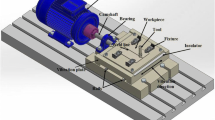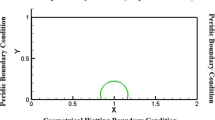Abstract
The aim of this work is devoted to the numerical modeling of the vibration effects on the hydrodynamic behavior of drops in additive manufacturing processes. A mathematical model of the liquid flow taking into account the surface tension force in the formalism of the smoothed particle hydrodynamics method (SPH) is proposed, which lets to directly consider the influence of vibrations through the introduction of additional boundary conditions. The verification of this SPH approach is carried out in comparison with experimental results, where the dependence of the value of the surface tension coefficient on the speed amplitude of the vibrations was determined. The SPH model satisfactorily describes the effect of a surface tension coefficient reduction for water under vibrations. Therefore, a series of numerical experiments to determine the effect of vibration influences on the value of the surface tension coefficient for 12\(\times \)18H10T steel in layer-by-layer wire cladding were conducted. It was found that the proposed SPH mathematical model is a promising numerical tool for further studying the effects of vibration influences in additive manufacturing processes.




















Similar content being viewed by others
References
Adami S, Hu XY, Adams NA (2012) A generalized wall boundary condition for smoothed particle hydrodynamics. J Comput Phys. https://doi.org/10.1016/j.jcp.2012.05.005
Adami S, Hu XY, Adams NA (2013) A transport-velocity formulation for smoothed particle hydrodynamics. J Comput Phys. https://doi.org/10.1016/j.jcp.2013.01.043
Antonelli L, Francomano E, Gregoretti F (2021) A cuda-based implementation of an improved SPH method on GPU. Appl Math Comput 409:125482
Balasubramanian K, Kesavan D, Balusamy V (2011) Studies on the effect of vibratory treatment on reduction of solidification cracking in AA2014 aluminum alloys. Revue de Métallurgie 108:89–94. https://doi.org/10.1051/metal/2011024
Blekhman LI (2013) Oscillation-induced suspension of solids in fluid and loose media (in Russian). PNRPU Mech Bull 2:52–83
Brackbill JU, Kothe DB, Zemach C (1992) A continuum method for modeling surface tension. J Comput Phys 100:335–354. https://doi.org/10.1016/0021-9991(92)90240-Y
Cho JH, Farson DF, Milewski JO, Hollis KJ (2009) Weld pool flows during initial stages of keyhole formation in laser welding. J Phys D Appl Phys 42:175502. https://doi.org/10.1088/0022-3727/42/17/175502
Cleary P, Ha J, Alguine V, Nguyen T (2002) Flow modelling in casting processes. Appl Math Model 26:171–190. https://doi.org/10.1016/S0307-904X(01)00054-3
Cui Y, Xu CL, Han Q (2006) Effect of ultrasonic vibration on unmixed zone formation. Scripta Materialia. https://doi.org/10.1016/j.scriptamat.2006.08.035
Dai WL (2003) Effects of high-intensity ultrasonic-wave emission on the weldability of aluminum alloy 7075–t6. Mater Lett 57:2447–2454. https://doi.org/10.1016/S0167-577X(02)01262-4
Das R, Cleary PW (2016) Three-dimensional modelling of coupled flow dynamics, heat transfer and residual stress generation in arc welding processes using the mesh-free SPH method. J Comput Sci 16:200–216
Davlyatshin RP, Gerasimov RM, Bayandin YV, Permyakov GL, Trushnikov DN (2021) Mathematical modeling the process of wire surfacing by the smoothed particle hydrodynamics method. J Phys: Conf Ser 1730:012003. https://doi.org/10.1088/1742-6596/1730/1/012003
Dragunov V, Goryachkina M, Gudenko A, Sliva A, Shcherbakov A (2019) Investigation of the optimal modes of electron-beam wire deposition. In: IOP Conference Series: Materials Science and Engineering, IOP Publishing, vol 681, p 012008
Farrow MM (1982) Laser/ultrasonic welding technique. J Acoustical Soc Am 72(6):2049
Gabreil E, Wu H, Chen C, Li J, Rubinato M, Zheng X, Shao S (2022) Three-dimensional smoothed particle hydrodynamics modeling of near-shore current flows over rough topographic surface. Frontiers in Marine Science 9. https://doi.org/10.3389/fmars.2022.935098, https://www.frontiersin.org/articles/10.3389/fmars.2022.935098
Galleguillos-Silva R, Vargas-Hernández Y, Gaete-Garretón L (2017) Wettability of a surface subjected to high frequency mechanical vibrations. Ultrason Sonochem 35:134–141. https://doi.org/10.1016/J.ULTSONCH.2016.09.011
Gershuni GZ, Lyubimov DV (1998) Thermal vibrational convection. John Wiley & Sons, Chichester, UK, https://www.wiley.com/en-us/Thermal+Vibrational+Convection-p-9780471973850
Gilgenbach RM (1996) S.i. anisimov and v.a. khokhlov, instabilities in laser-matter interaction, crc press, boca raton, fl (1995). 141 pages, isbn 0-8493-8660-8. Laser and Particle Beams 14:797–798, https://doi.org/10.1017/S0263034600010491
Gorunov AI, Aigul RG, Aidar NM, Albert KG (2018) Prospects for laser-acoustic additive manufacturing method for aluminium alloys (in Russian). Adactive technologies: the present and the future proceedings of the IV international conference FGUP “all-russian research institute of aviation materials” pp 192–202
He L, Wu M, Li L, Hao H (2006) Ultrasonic generation by exciting electric arc: a tool for grain refinement in welding process. Appl Phys Lett 10(1063/1):2357857
Hu R, Luo M, Liu T, Liang L, Huang A, Trushnikov D, Karunakaran KP, Pang S (2019) Thermal fluid dynamics of liquid bridge transfer in laser wire deposition 3D printing. Sci Technol Weld Join 24:401–411. https://doi.org/10.1080/13621718.2019.1591039
Ilya VT, Bulat AK, Anton SM (2018) Mathematical modelling of ultrasonic field influence on metal melt (in Russian). New Technologies, Materials And Equipment Of Russian Aviacomic Industry All-Russian Scientific And Practical Conference With International Participation pp 520–526
Ji F, Qin X, Hu Z, Xiong X, Ni M, Wu M (2022) Influence of ultrasonic vibration on molten pool behavior and deposition layer forming morphology for wire and arc additive manufacturing. Int Commun Heat Mass Trans 130:105789. https://doi.org/10.1016/J.ICHEATMASSTRANSFER.2021.105789
Kellogg F, Vasilev E, Kudzal A, Taggart-Scarff J, Marsico J, Knezevic M, McWilliams B (2022) Physical simulations of heat-affected zone microstructures to compare weldability characteristics of additively manufactured and wrought 17–4 stainless steel. Mater Charact 185:111714. https://doi.org/10.1016/J.MATCHAR.2021.111714
Khairallah SA, Anderson AT, Rubenchik A, King WE (2016) Laser powder-bed fusion additive manufacturing: Physics of complex melt flow and formation mechanisms of pores, spatter, and denudation zones. Acta Mater 108:36–45. https://doi.org/10.1016/J.ACTAMAT.2016.02.014
Komen H, Baba H, Kadota K, Era T, Tanaka M, Terasaki H (2020) Three-dimensional particle simulation of buried space formation process during high current gas metal arc welding. J Adv Join Process 1:100019
Krivonosova EA, Schitsin YD, Trushnikov DN, Myshkina AV, Akulova SN, Neulibin SD, Dushina AY (2018) Structure formation of high-temperature alloy by plasma, laser and TIG surfacing. J Phys: Conf Ser 1089:012019. https://doi.org/10.1088/1742-6596/1089/1/012019
Kumar S, Wu CS, Padhy GK, Ding W (2017) Application of ultrasonic vibrations in welding and metal processing: a status review. J Manuf Process. https://doi.org/10.1016/j.jmapro.2017.02.027
Lei YC, Wang ZW, Chen XZ (2011) Effect of arc-ultrasound on microstructures and mechanical properties of plasma arc welded joints of sicp/al mmcs. Trans Nonferrous Metals Soc China (English Edition). https://doi.org/10.1016/S1003-6326(11)60709-7
Leitz KH, Grohs C, Singer P, Tabernig B, Plankensteiner A, Kestler H, Sigl LS (2018) Fundamental analysis of the influence of powder characteristics in selective laser melting of molybdenum based on a multi-physical simulation model. Int J Refract Metal Hard Mater 72:1–8. https://doi.org/10.1016/J.IJRMHM.2017.11.034
Lyubimov DV, Lyubimova TP, Cherepanov AAA (2003) Dynamics of interface surfaces in vibrating fields. FIZMATLIT, https://www.studentlibrary.ru/book/ISBN9785922104562.html
Monaghan JJ (1992) Smoothed particle hydrodynamics. Ann Rev Astron Astrophys 30(1):543–574. https://doi.org/10.1146/annurev.aa.30.090192.002551
Natsui S, Tonya K, Nakajima D, Kikuchi T, Nogami H (2022) Droplet behavior analysis on inclined, highly sticky, or slippery superhydrophobic nanostructured surfaces by observation and SPH simulation. Chem Eng Sci 248:117214
Nezhadfar PD, Thompson S, Saharan A, Phan N, Shamsaei N (2021) Structural integrity of additively manufactured aluminum alloys: effects of build orientation on microstructure, porosity, and fatigue behavior. Addit Manuf 47:102292. https://doi.org/10.1016/J.ADDMA.2021.102292
Qingmei L, Yong Z, Yaoling S, Feipeng Q, Qijie Z (2007) Influence of ultrasonic vibration on mechanical properties and microstructure of 1Cr18Ni9Ti stainless steel. Mater Design 28:1949–1952. https://doi.org/10.1016/j.matdes.2006.04.025
Shcherbakov AV, Gaponova DA, Rodyakina RV (2020) Numerical modeling of heat transfer and material flow during wire-based electron-beam additive manufacturing. Lecture Notes in Mech Eng. https://doi.org/10.1007/978-3-030-22063-1_119
Temperton RH, Smith MI, Sharp JS (2015) Mechanical vibrations of pendant liquid droplets. Eur Phys J E 38:79. https://doi.org/10.1140/epje/i2015-15079-2
Todaro CJ, Easton MA, Qiu D, Zhang D, Bermingham MJ, Lui EW, Brandt M, StJohn DH, Qian M (2020) Grain structure control during metal 3D printing by high-intensity ultrasound. Nature Commun. https://doi.org/10.1038/s41467-019-13874-z
Tong M, Browne DJ (2014) An incompressible multi-phase smoothed particle hydrodynamics (SPH) method for modelling thermocapillary flow. Int J Heat Mass Transf 73:284–292. https://doi.org/10.1016/j.ijheatmasstransfer.2014.01.064
Trushnikov DN, Koleva EG, Davlyatshin RP, Gerasimov RM, Bayandin YV (2019) Mathematical modeling of the electron-beam wire deposition additive manufacturing by the smoothed particle hydrodynamics method. Mech Adv Mater Modern Process 5:4. https://doi.org/10.1186/s40759-019-0044-1
Trushnikov DN, Permyakov GL, Varushkin SV, Davlyatshin RV, Bayandin YV, Pang S (2021) Improving the electron-beam additive manufacturing growth of components. Russ Eng Res 41:874–876. https://doi.org/10.3103/S1068798X21090276
Tshephe TS, Akinwamide SO, Olevsky E, Olubambi PA (2022) Additive manufacturing of titanium-based alloys- a review of methods, properties, challenges, and prospects. Heliyon 8:e09041 https://doi.org/10.1016/J.HELIYON.2022.E09041, https://linkinghub.elsevier.com/retrieve/pii/S2405844022003292
Vacondio R, Altomare C, De Leffe M, Hu X, Le Touzé D, Lind S, Marongiu JC, Marrone S, Rogers BD, Souto-Iglesias A (2021) Grand challenges for smoothed particle hydrodynamics numerical schemes. Comput Particle Mech 8(3):575–588
Wang S, Kang J, Guo Z, Lee TL, Zhang X, Wang Q, Deng C, Mi J (2019) In situ high speed imaging study and modelling of the fatigue fragmentation of dendritic structures in ultrasonic fields. Acta Mater 165:388–397. https://doi.org/10.1016/J.ACTAMAT.2018.11.053
Wu W (2000) Influence of vibration frequency on solidification of weldments. Scripta Materialia. https://doi.org/10.1016/S1359-6462(99)00416-9
Yoon YC, Song JH (2021) Interface immersed particle difference method for weak discontinuity in elliptic boundary value problems. Comput Methods Appl Mech Eng 375:113650
Zen’kovskaya S, Novosiadliy V (2011) Averaging method and long-wave asymptotics in vibrational convection in layers with an interface. J Eng Math 69:277–289. https://doi.org/10.1007/s10665-010-9415-7
Zhang H, Zhang Z, He F, Liu M (2022) Numerical investigation on the water entry of a 3d circular cylinder based on a gpu-accelerated sph method. Eur J Mech B Fluids 94:1–16. https://doi.org/10.1016/J.EUROMECHFLU.2022.01.007
Acknowledgements
The work was financially supported by the Ministry of Education and Science of Perm Krai (contract S-26/512) (mathematical model development of additive manufacturing process), the Russian Foundation for Basic Research (RFBR Project No. 20-48-596006 r_NOTs_Permskii Krai) (mathematical model improvement with vibration influences), the Ministry of Science and Higher Education of the Russian Federation (state task No. FSNM-2020-0028 and state task No. FSNM-2021-0011) (field experiments).
Author information
Authors and Affiliations
Corresponding authors
Ethics declarations
Conflict of interest
The authors declare that they have no conflict of interest.
Additional information
Publisher's Note
Springer Nature remains neutral with regard to jurisdictional claims in published maps and institutional affiliations.
Rights and permissions
Springer Nature or its licensor (e.g. a society or other partner) holds exclusive rights to this article under a publishing agreement with the author(s) or other rightsholder(s); author self-archiving of the accepted manuscript version of this article is solely governed by the terms of such publishing agreement and applicable law.
About this article
Cite this article
Davlyatshin, R.P., Perminov, A.V., Bayandin, Y.V. et al. Numerical modeling of vibration effects on the surface tension of a liquid drop in additive technologies with SPH. Comp. Part. Mech. 10, 911–928 (2023). https://doi.org/10.1007/s40571-022-00536-z
Received:
Revised:
Accepted:
Published:
Issue Date:
DOI: https://doi.org/10.1007/s40571-022-00536-z




